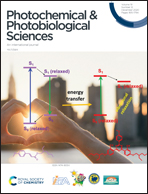Luciferase isozymes from the Brazilian Aspisoma lineatum (Lampyridae) firefly: origin of efficient pH-sensitive lantern luciferases from fat body pH-insensitive ancestors†
Abstract
Firefly luciferases usually emit green-yellow bioluminescence at physiological pH values. However, under acidic conditions, in the presence of heavy metals and, at high temperatures they emit red bioluminescence. To understand the structural origin of bioluminescence colors and pH-sensitivity, about 20 firefly luciferases have been cloned, sequenced and investigated. The proton and metal-binding site responsible for pH- and metal sensitivity in firefly luciferases was shown to involve the residues H310, E311 and E354 in firefly luciferases. However, it is still unclear how and why pH-sensitivity arose and evolved in firefly luciferases. Here, we cloned and characterized two novel luciferase cDNAs from the fat body and lanterns of the Brazilian firefly Aspisoma lineatum. The larval fat body isozyme (AL2) has 545 residues, and displays very slow luminescence kinetics and a pH-insensitive spectrum. The adult lantern isozyme (AL1) has 548 residues, displays flash-like kinetics and pH and metal sensitive bioluminescence spectra, and is at least 10 times catalytically more efficient than AL2. Thermostability and CD studies showed that AL2 is much more stable and rigid than the AL1 isozyme. Multialignment and modelling studies show that the E310Q substitution (E310 in AL2 and Q310 in AL1) may have been critical for the origin of pH-sensitivity in firefly luciferases. The results indicate that the lantern efficient flash-emitting pH-sensitive luciferases arose from less efficient glow-type pH-insensitive luciferases found in the fat body of ancestral larval fireflies by enzyme structure flexibilization and substitution at position 310.



 Please wait while we load your content...
Please wait while we load your content...